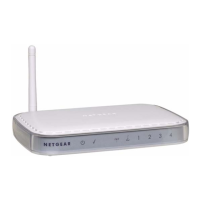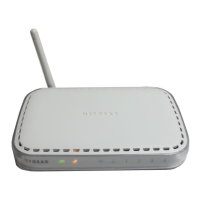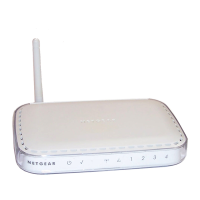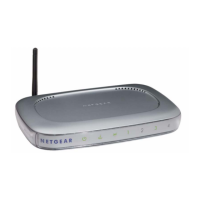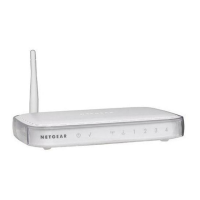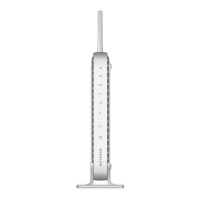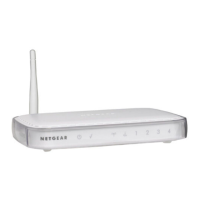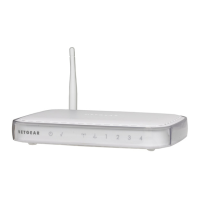Do you have a question about the NETGEAR WGT634U and is the answer not in the manual?
Describes the intended audience, scope, conventions, and formats used in this manual.
Explains how to navigate and utilize the HTML version of the manual.
Provides options for printing the manual or its chapters.
Provides an overview of the NETGEAR WGT634U Wireless Media Router's capabilities.
Highlights the main features and functionalities of the WGT634U router.
Details the router's capability to store and share files via a USB drive.
Explains the Demilitarized Zone (DMZ) feature for exposing one IP address.
Describes the 802.11g wireless access point features.
Covers the router's firewall capabilities including content filtering.
Discusses the security features integrated into the router.
Lists the various network protocols supported by the router.
Details features that simplify router setup and ongoing management.
Describes the LEDs and ports located on the front of the router.
Details the ports and buttons found on the rear of the router.
Lists prerequisites for connecting the router to the internet.
Specifies the computer's network configuration needs for setup.
Guide to recording essential ISP configuration details.
Step-by-step instructions for physically connecting the router.
Guides through the process of establishing basic wireless connection.
Provides manual steps for configuring the internet connection.
Offers tips for optimizing wireless performance and placement.
Details how to enhance the security of your wireless network.
Explains the various wireless settings available for configuration.
Covers WEP authentication and encryption methods for security.
Guides on using MAC address filtering to control network access.
Provides steps for setting up WEP data encryption on the router.
Outlines common scenarios for sharing files via the USB drive.
Details how to share photos and multimedia with friends and family.
Explains how to connect a USB drive to the router.
Guides setup for remote access to the USB drive over the internet.
Describes how to grant FTP access rights to USB drive users.
Instructions for accessing the USB drive via a local web browser.
Steps for accessing the USB drive from a remote computer.
Details how to block specific internet sites by keywords or addresses.
Explains how to block specific internet services or ports.
Allows setting schedules for when content filtering is active.
Sets up email alerts and notifications for web access logs.
Displays the current status and usage information of the router.
Shows a list of devices discovered on the local network.
Provides instructions on how to update the router's firmware.
Covers saving and retrieving router configuration settings.
Guides on how to change the router's administrator password.
Details how to make local servers accessible via the internet.
Explains WAN setup options like DMZ server and MTU size.
Guides on configuring dynamic DNS for domain name resolution.
Covers configuration of LAN IP services like DHCP and RIP.
Details how to configure the router to act as a DHCP server.
Provides instructions for configuring static routes for network traffic.
Explains how to allow internet users to manage the router remotely.
Describes UPnP for seamless device networking and discovery.
Covers basic checks for router power and LED indicators.
Troubleshooting steps for when the power LED is off.
Steps to resolve issues accessing the router's web interface.
Guides on resolving problems with the internet service provider connection.
Explains using the ping utility for TCP/IP network diagnostics.
Details how to restore factory defaults for configuration and password.
Covers common issues related to USB drive connectivity and functionality.
Provides guidance for resolving firmware upgrade issues.
Lists network protocols and standards the router supports.
Details technical specifications related to the wireless interface.
Lists RFC documents for further information on networking.
Explains fundamental concepts related to network routers.
Details IP addressing structure and its relation to the internet.
Explains the function and format of a netmask in IP addressing.
Describes subnetting techniques for dividing IP networks.
Covers the use and assignment of private IP address ranges.
Explains how NAT allows multiple PCs to share a single IP address.
Details MAC addresses and the ARP protocol for address resolution.
Explains how DHCP automatically configures IP settings.
Defines a firewall and its role in network security.
Steps to prepare computers for TCP/IP networking.
Guides on configuring TCP/IP settings using DHCP automatically.
How to collect ISP configuration details for Windows PCs.
Steps to configure TCP/IP networking for Macintosh computers.
Provides an overview of wireless networking standards and modes.
Describes wireless operation in infrastructure mode with an access point.
Explains wireless authentication methods and WEP data encryption.
Details the authentication services governing 802.11 device communication.
Discusses Wi-Fi Protected Access (WPA) security enhancements.
Compares WPA security features against WEP.
Explains enterprise-level WPA authentication using 802.1x and RADIUS.
A list of technical terms and their definitions used in the manual.
Defines port-based network access control for authentication.
Network Address Translation technique for sharing IP addresses.
Wired Equivalent Privacy, a data encryption protocol for wireless networks.
The name assigned to a wireless network for identification.
Describes the intended audience, scope, conventions, and formats used in this manual.
Explains how to navigate and utilize the HTML version of the manual.
Provides options for printing the manual or its chapters.
Provides an overview of the NETGEAR WGT634U Wireless Media Router's capabilities.
Highlights the main features and functionalities of the WGT634U router.
Details the router's capability to store and share files via a USB drive.
Explains the Demilitarized Zone (DMZ) feature for exposing one IP address.
Describes the 802.11g wireless access point features.
Covers the router's firewall capabilities including content filtering.
Discusses the security features integrated into the router.
Lists the various network protocols supported by the router.
Details features that simplify router setup and ongoing management.
Describes the LEDs and ports located on the front of the router.
Details the ports and buttons found on the rear of the router.
Lists prerequisites for connecting the router to the internet.
Specifies the computer's network configuration needs for setup.
Guide to recording essential ISP configuration details.
Step-by-step instructions for physically connecting the router.
Guides through the process of establishing basic wireless connection.
Provides manual steps for configuring the internet connection.
Offers tips for optimizing wireless performance and placement.
Details how to enhance the security of your wireless network.
Explains the various wireless settings available for configuration.
Covers WEP authentication and encryption methods for security.
Guides on using MAC address filtering to control network access.
Provides steps for setting up WEP data encryption on the router.
Outlines common scenarios for sharing files via the USB drive.
Details how to share photos and multimedia with friends and family.
Explains how to connect a USB drive to the router.
Guides setup for remote access to the USB drive over the internet.
Describes how to grant FTP access rights to USB drive users.
Instructions for accessing the USB drive via a local web browser.
Steps for accessing the USB drive from a remote computer.
Details how to block specific internet sites by keywords or addresses.
Explains how to block specific internet services or ports.
Allows setting schedules for when content filtering is active.
Sets up email alerts and notifications for web access logs.
Displays the current status and usage information of the router.
Shows a list of devices discovered on the local network.
Provides instructions on how to update the router's firmware.
Covers saving and retrieving router configuration settings.
Guides on how to change the router's administrator password.
Details how to make local servers accessible via the internet.
Explains WAN setup options like DMZ server and MTU size.
Guides on configuring dynamic DNS for domain name resolution.
Covers configuration of LAN IP services like DHCP and RIP.
Details how to configure the router to act as a DHCP server.
Provides instructions for configuring static routes for network traffic.
Explains how to allow internet users to manage the router remotely.
Describes UPnP for seamless device networking and discovery.
Covers basic checks for router power and LED indicators.
Troubleshooting steps for when the power LED is off.
Steps to resolve issues accessing the router's web interface.
Guides on resolving problems with the internet service provider connection.
Explains using the ping utility for TCP/IP network diagnostics.
Details how to restore factory defaults for configuration and password.
Covers common issues related to USB drive connectivity and functionality.
Provides guidance for resolving firmware upgrade issues.
Lists network protocols and standards the router supports.
Details technical specifications related to the wireless interface.
Lists RFC documents for further information on networking.
Explains fundamental concepts related to network routers.
Details IP addressing structure and its relation to the internet.
Explains the function and format of a netmask in IP addressing.
Describes subnetting techniques for dividing IP networks.
Covers the use and assignment of private IP address ranges.
Explains how NAT allows multiple PCs to share a single IP address.
Details MAC addresses and the ARP protocol for address resolution.
Explains how DHCP automatically configures IP settings.
Defines a firewall and its role in network security.
Steps to prepare computers for TCP/IP networking.
Guides on configuring TCP/IP settings using DHCP automatically.
How to collect ISP configuration details for Windows PCs.
Steps to configure TCP/IP networking for Macintosh computers.
Provides an overview of wireless networking standards and modes.
Describes wireless operation in infrastructure mode with an access point.
Explains wireless authentication methods and WEP data encryption.
Details the authentication services governing 802.11 device communication.
Discusses Wi-Fi Protected Access (WPA) security enhancements.
Compares WPA security features against WEP.
Explains enterprise-level WPA authentication using 802.1x and RADIUS.
A list of technical terms and their definitions used in the manual.
Defines port-based network access control for authentication.
Network Address Translation technique for sharing IP addresses.
Wired Equivalent Privacy, a data encryption protocol for wireless networks.
The name assigned to a wireless network for identification.
| Wireless Standards | 802.11g, 802.11b |
|---|---|
| Frequency Band | 2.4 GHz |
| Maximum Wireless Speed | 54 Mbps |
| Wireless Data Rates | 54, 48, 36, 24, 18, 12, 11, 9, 6, 5.5, 2, 1 Mbps |
| Ports | 4 x 10/100 Mbps LAN |
| Security | WEP, WPA, WPA2 |
| Antennas | 2 x External Antennas |

